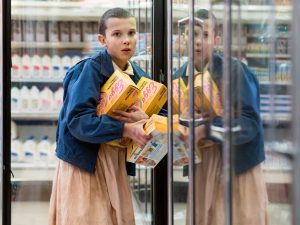Product Placement: Do You Believe in Magic?
Published on March, 6, 2020 at 5:48 p.m.
by Faith Saucier.

Oh, the art of product placement. When it’s done right, it’s one of the most subtle forms of advertising there is — content embedded so seamlessly into a production that you’d think someone ran over it with an iron.
It exists in many forms, harbors many risks and adds quite a few zeros to the end of a check. But when it comes to reaching audiences, it’s an all-or-nothing, highly influential technique that — again, when done right — will have consumers singing praises for your product and its placement in their favorite show or movie.
Overcoming the advertising stigma
It’s a well-known fact that the stigma around traditional advertising has grown over the years. Not only do audiences worry about businesses’ ability to access their personal information, but they also just simply don’t enjoy seeing advertisements on television, streaming services or social media.
“People just generally don’t like watching ads,” said Ian Zimmerman, professor of psychology at the University of Minnesota Duluth. “The popularity of ad-blocking software speaks at just how much people don’t want to watch traditional ads.”
The general disdain for traditional advertising has led to product placement becoming part of the growing trend toward “native advertising,” which, according to Nancy Trent, president and CEO of Trent & Company, is currently one of the fastest-growing advertising strategies in the market.
“If utilized correctly, native advertising does not feel like an advertisement, and audiences are more likely to consume the content,” said Trent. “This allows brands to get their messages across to a broad audience without being avoided.”
Product placement is an excellent strategy for overcoming the public’s aversion toward advertising. Placements simply cannot be ignored, and they can have extremely positive effects for your brand. “Product placement has huge potential in reaching broad audiences,” noted Trent. “It then goes beyond being simply an advertisement — to consumers, these products become a part of their lifestyle.”
You’ve got to do it right
If it’s not subtle, your brand is going nowhere.

Perfecting the product placement practice is not easy — but it must be done. The audiences that consume your content don’t want to be hit over the head with your product — blatantly projected on-screen — in their favorite television show or movie. There’s an art to the practice, and the biggest impact for your brand arises when audiences see that art come to life in a real, organic way.
“When you see something in a scene, and it’s organic, it’s natural, it’s not a stretch for the character to be surrounding that — it adds a sense of realism,” said Stacy Jones, CEO of Hollywood Branded, an influencer marketing and product placement agency in Los Angeles.
With product placement, there’s a path to success and a path to failure. The brands that fail are the ones who ignore the rules, if you will, to producing a quality placement that makes a lasting impact.
“There are smart ways to do a product placement,” said Paul Suggett, freelance copywriter and creative director, in a recent article. “There are also ways that go to the extreme. Back to the Future did a great job of incorporating products in a fun way. But in part two, Texaco basically had a 10-second ad in the movie.”
Hosting an advertisement for your product in the middle of a movie isn’t the way to go about product placement. It takes audiences out of the scene and will ultimately lead to a negative response for your brand. “Just take a look at the way a series like Days of Our Lives does it,” explained Suggett. “It’s about as subtle as a sledgehammer.”
For brands, it may be quite a learning curve. But there is a right way — a so-called “highway to heaven” — to place your product in front of an audience so that it brings life to your brand. The entertainment marketing report done by Hollywood Branded in 2015 stated that 85% of people report that they recognize product placement in television and film, and 60% of audiences feel more positive about the brands they recognize in a placement.
“We like being immersed in content,” Jones said. “We like the content to seem and appear real to our everyday lives. When it’s done how the craft is supposed to be done, it makes it more relevant to us. That’s why I think so many people respond positively when they see product placement.”
Where do PR pros come in?
Product placement isn’t just about advertising. It’s about creating and embedding content in a natural way, promoting your brand, and building relationships with clients, influencers, the media and, of course, audiences.
The goal is to make better content when working with brands, according to Jones.
Trent believes that the editorial team also plays a huge role in creating a quality placement, along with pursuing celebrities and gaining media exposure. “The editorial team is responsible for making sure product placements fit into the story line,” Trent said.
She also noted that “[s]mart brand managers pursue celebrities for third-party endorsements to tap into their core audience” and that “you need media exposure, celebrities and social impact used together to make the real impact on the consumers. Media exposure is the key to success.”
So, where do we go from here?
The practice of product placement has been around for decades, and promises to retain its popularity. Simply put, the future of the product placement industry is bright. However, it comes with its own set of challenges for companies to overcome.
The solution to those challenges: content, good content and better content.
Content is extremely engaging, and it’s everything to product placement. Audiences are hungry for it — and, interestingly enough, they love it when placements run adjacent to commercials. According to Priceonomics, “placements can complement the performance of ads running adjacent to the integration. The Journal of Management and Marketing Research estimates that 57.5% of [television] viewers recognized a brand in a placement when the brand also was advertised during the show.”
Jones agrees. “There’s some magic that happens when you’re taking a product from the ad and into the content, or from the content and into the ad,” she said.
The effects of those placements are quite magical, too.
Product placement takes your brand beyond just a traditional advertisement. It takes audiences beyond the base level of content that can connect them to your brand. It is so much more than just a scene in a movie or television show.
“Product placement has a bigger impact on the consumers, as it truly resonates with them,” said Trent. “Brands become aspirational.”
Hollywood Branded’s website lists a variety of benefits from getting into the product placement practice, including the ability to launch your brand, increase product awareness, build brand loyalty and be part of the scene.
According to Jones, product placement is about brand-building, creating and identifying engaging content — “content that can build natural, organic, good partnerships that share a voice” — and embracing pop culture.
“The opportunities are really, really wide,” said Jones. “It can really be a game changer for brands.”
So, brands, do you believe in magic?




